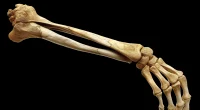Elbow fracture
What’s that?
An elbow fracture is a predominantly intra-articular injury in the elbow, characterized by disruption of the integrity of the bone.
About the disease
The proximal end of the ulna ends with the olecranon. It forms the elbow joint and allows movement in the frontal plane, limiting excessive extension.
Elbow fractures are among the most common mechanical injuries of the elbow joint. These injuries occur most often in young people who lead an active lifestyle. This localization of fractures belongs to the category of complex fractures, as the joint is involved, and the damaged bone segments are often displaced.
Fractures of the olecranon are manifested by severe pain, swelling, and bleeding in the soft tissues. The function of flexion and extension of the elbow joint is impaired, and it becomes impossible to hold objects in the injured arm. Diagnosis is based on the data of objective examination and radiographic scanning.
Treatment of fractures of this localization requires an individual approach. In case of incomplete bone damage, conservative tactics are applicable, while in case of complete damage, surgical intervention is often indicated due to the frequent separation of bone fragments.
Types
According to the classification, the following types of fracture are distinguished:
- Isolated injury, when there is only a defect of bone integrity in the region of the elbow;
- Combined, when the fracture is combined with dislocation of the bones in the elbow joint or concomitant fractures at the level of the radius or ulna, including involvement of the styloid process.
According to the condition of the bone fragments and the mechanism of injury, there are possible types, such as fragmentary, linear, oblique, and other fracture types.
Symptoms of an elbow fracture
The symptoms of an elbow fracture are as follows:
- Intense pain in the elbow joint area;
- Increased pain sensations when trying to bend-extend the arm;
- forced position of the limb – holding the arm bent at the elbow;
- swelling of soft tissues and lividity of the skin – these signs appear 2-3 hours after the injury.
Sometimes, palpation may reveal a gap between the damaged bone segments along the posterior surface of the elbow joint.
Reasons
Usually, damage to the olecranon is associated with a person falling on a bent elbow. Such injuries most often occur in everyday life. Sometimes, a fracture of this localization is associated with a direct impact on the posterior surface of the elbow, including car accidents. In some cases, a detachment mechanism of injury is possible with a sharp contraction of muscle bundles fixed to the elbow (triceps muscle).
Diagnosis
A radiographic examination is prescribed to establish a definitive diagnosis. The most informative scans are those obtained with the elbow in a bent position (right angle of flexion is recommended). The scans clearly visualize the line of injury (darker) and the position of the bone fragments, including the degree of their divergence. A CT scan may be required to detail pathologic changes and carefully plan surgical intervention.
Treatment of elbow fracture
The specifics of the injury determine the treatment program for elbow fracture. For milder injuries, a conservative approach is possible; for severe injuries, surgical intervention is required.
Conservative treatment
Conservative treatment of elbow fractures consists of closed manual repositioning and subsequent immobilization with a plaster cast with the elbow and wrist joint. Often, this treatment option has little effect if there is a significant divergence of the bone fragments. Immobilization with plaster does not reliably stabilize the bone fragments, which may even result in lysis of the injured segments.
Thus, conservative tactics are applicable in the following cases:
- incomplete fracture (fracture);
- insignificant divergence of bone fragments, which does not exceed 2-3 mm.
The circular plaster cast is applied with the elbow flexed. It provides the best conditions for the fracture to progress to the consolidation stage.
Surgical treatment
Surgical treatment is recommended when the bone fragments are significantly separated, and the gap between them is more than 3 mm. Thanks to surgery, it is possible to accurately match the injured segments, ensure their reliable fixation, and make caring for the injured hand easier. Currently, the primary method of surgery is metal osteosynthesis. It involves the juxtaposition and fixation of the fragments with the help of tip plates, intraosseous screws, and compression rods. After fixation of bone fragments with a plate, there is no need for a plaster cast. It is sufficient to support the arm bent at the elbow with a headband.
All these treatment options are available in more than 800 hospitals worldwide (https://doctor.global/results/diseases/elbow-fracture). For example, Elbow fracture surgery can be performed in 46 clinics across Germany for an approximate price of $7.9 K (https://doctor.global/results/europe/germany/all-cities/all-specializations/procedures/elbow-fracture-surgery).
Prevention
Prevention is aimed at preventing injuries. Caution should be exercised during icy conditions of roads and high-rise work in the home.
Rehabilitation after elbow fracture
Rehabilitation after an elbow fracture includes the development of the elbow joint, which can become stiff during immobilization. For this purpose, special therapeutic exercises with a gradual increase in load are recommended. Physical procedures and massage are also used in the complex. After developing the joint, taping may be recommended. Taping improves the functioning of the joint and prevents its overloading.




